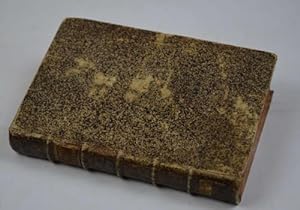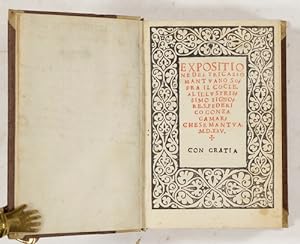tricasso (4 Ergebnisse)
Produktart
- Alle Produktarten
- Bücher (4)
- Magazine & Zeitschriften
- Comics
- Noten
- Kunst, Grafik & Poster
- Fotografien
- Karten
-
Manuskripte &
Papierantiquitäten
Zustand
- Alle
- Neu
- Antiquarisch/Gebraucht
Einband
- alle Einbände
- Hardcover (1)
- Softcover
Weitere Eigenschaften
- Erstausgabe (2)
- Signiert (1)
- Schutzumschlag
- Angebotsfoto (2)
Land des Verkäufers
Verkäuferbewertung
-
Epitoma chyromantico di Patritio Tricasso da Cerasari mantouano. Nel quale si contiene tutte l'opere per esso Tricasso in questa scientia composte, con assai figure, & dichiarationi agiunte. Facilissimo ad imparare, et in brevissimo tempo.
Verlag: (Stampato in Venetia : per Agostino de Bindoni, ), 1538
Anbieter: Antiquariat Hartmut R. Schreyer, Augsburg, Deutschland
Erstausgabe
8º. 344 p. with 78 large woodcut text illustrations of hands , woodcut vignettes on title and verso, and printer?s mark. Old simple cardboards. First edition (previously published a commentary on Cocles (1525). - Graesse, Bibl. mag. 107. - Rosenthal, 1024. - Tricasso (1491-c. 1550) was a Dominican and a mathematician from Mantua. - (Dedica datata erroneamente 1635 / preface misprinted 1635). - Aus der Bibliothek des Grafen Maximilian Joseph von LAMBERG (geb. 22. November 1729 in Brünn; gest. 23. Juni 1792 in Kremsier) mit dessen Exlibris ,Le comte Max Lamberg? Graf Lamberg war Oberhofmarschall beim Bischof von Augsburg und Schriftsteller. Er reiste u.a. mit dem Hochstabler u. Alchemisten Graf von Saint Germain und verkehrte mit Casanova (vgl. Casanova und Graf Lamberg : unveröffentlichte Briefe des Grafen Max Lamberg an Casanova aus dem Schloßarchiv in Dux / hrsg. von Gustav Gugitz. 1935) - (Exlibris etwas defekt; weiterer Name auf Titel; 1 Ecke durchgehend feuchtrandig; Einband etwas angestaubt und fleckig) - Selten / rare!.
-
COMENTARIOS CLARÍSIMOS SOBRE LA QUIROMANCIA DE COCLES HECHOS POR TRICASSO DE MANTUA. 2 TOMOS. Introducción, traducción y notas de F. Sánchez Salor. Edición facsímil de la de 1525.
Verlag: Badajoz: Editoria Regional de Extremadura / Junta de Extremadura / Consejería de Cultura, 2000., 2000
Anbieter: Librería Antonio Castro, SEVILLA, SE, Spanien
8vo. Volumen facsímil sin paginación (500 pp aprox.). Volumen complementario: 645 pp. Encuadernación editorial en estuche en tela, con dos compartimentos. Facsímil con encuadernación símil pergamino editorial. Volumen complementario encuadernado en rústica editorial. Excelente estado. Colección: Biblioteca de Barcarrota, vol. 4.
-
Epitoma chyromantico& nel quale si contiene tutte l'opere per esso Tricasso in questa scienza composte, con assai figure, et dichiarationi agiunte. Facilissimo ad imparare, et in brevissimo tempo.
Verlag: per Agostino Bindoni,, In Venetia,, 1538
Anbieter: Studio Bibliografico Benacense, Riva del garda, Italien
Cm. 15, pp. 344. Grande vignetta al frontespizio e molte figure in xilografia nel testo. Solida legatura settecentesca in piena pergamena rigida dipinta. Dorso a nervi con titoli in oro su tassello. Tagli colorati e sguardie marmorizzate. Ex libris nobiliare. Una piccola lacuna causata da mancanza marginale di carta (d'origine?), peraltro esemplare genuino ed in ottimo stato di conservazione. Bella e non comune edizione di quest'opera con cui il mantovano Tricasso offre una nuova e compiuta spiegazione dell'arte chiromantica partendo dalla spiegazione etimologica: "questa scientia e dottrina è un modo di pronosticare et indovinare le cose future, concesse solo tra huomini sapienti, per quei segni e linee quali nelle mani nostre si ritrovano". Cfr. Brunet V 945; Caillet 10830.
-
Expositione del Tricasso Mantuano sopra il Cocle . (colla traduzione della Chiromantia).
Erscheinungsdatum: 1525
Anbieter: Antiq. F.-D. Söhn - Medicusbooks.Com, Marburg, Deutschland
Buch Erstausgabe Signiert
Colophon: Impresse in Venetia . per Helisabetta De Rusconi . 1525, 8°, 239 leaves (Sign.A-Z, Aa-Gg), with woodcuts, Halfparchment 19th. century. First Italian Edition of this famous and early book on Chiromancy with interesting woodcuts, chiromantic figures and diagrams, present here in a fine and fresh copy with wide margins! Title in red within woodcut border, white on black; woodcut diagrams of hands in text; initials. Colophon: " Qua terminano le Dillucidatione dil Tricasso da Carasari Mantuano. Al illutrißimo signore S. Federico Gonzaga Marchese Mant. Impreße in Ventia regnante lo inclito Principe Andrea Gritti. Per Helisbetta de Rusconi. Nel anno del signore 1525. Adi primo del mese Aprile. "Many of his disciples asked Cocles which was the truer, physiognomy or chiromancy. His reply was that both were equally reliable, but that chiromancy had more fixed roots, since the lines of the hand remain the same from birth, while the physiognomy may alter. Many things may be learned from physiognomy which chiromancy does not reveal and vice versa. But chiromancy is a subdivision of physiognomy. Codes further distinguished between physionomia mctkaphorica and physionomia confusa, the latter being that which we know in part and are in part ignorant of and which is worked out gradually in practice with great labor." Ferguson V, pp.50-68 Bartolomeo della Rocca, also known as Cocles (1467-1504) was a scholar of chiromancy, physiognomy, astrology, and geomancy who lived in Bologna, Italy during the rule of the House of Bentivoglio from 1323 to 1506. In the months which preceded April, 1498, he participated (with others) in the preparation of a list of predictions relating to the life expectancies of different personalities for Giovanni Bentivoglio, dictator of Bologna and father of his boss Alessandro Bentivoglio. The work of Bartolomeo della Rocca was promoted by the Italian philosopher Alessandro Achillini. His main work, Chiromantie ac physionomie anastasis was published in 1504 then the Compendio of Fisiognomica ("Compendium of Physiognomics"), was published after his death, in 1553 in Strasbourg. Bartolomeo della Rocca was assassinated by the Italian condottiero Ermes Bentivoglio because of his prediction that Ermes would die in battle. See - Ahonen, Marke (28 July 2013). Medieval and Early Modern Physiognomy. Studies in the History of Philosophy of Mind. 12. pp. 633-637 Ziegler, Joseph (2004). "Médecine et physiognomonie du XIVVe au début du XVIe siècle". Médiévales (in French). 46: 89-108. Retrieved 14 January 2016. Ziegler, Joseph. "The Medieval Foundation of Renaissance physiognomy". Ecole Normale Supérieure de Paris. Retrieved 14 January 2016. Paride da Ceresara, detto Tricasso "(10 February 1466 - 1532) was an Italian humanist, poet, alchemist and astrologer. He was born in Ceresara and was descended from the Ceresara, a noble family. He was in the service of Isabella d'Este in Mantua and came up with the mythological, allegorical and celebratory themes for at least two of the paintings in her noted studiolo and perhaps the whole cycle. Paride collected and translated classical works such as Plautus' Aulularia and also studied Hebrew. He also wrote a number of erotic sonnets, signed with his pseudonyms Patrizio Tricasso and Patrizio Tricasso da Ceresara. He was hosted at the court of Aloisio Gonzaga in Castel Goffredo as an astrologer. He was summoned to Mantua in 1532 by Federico II Gonzaga to become podestà of the city, where Paride built the Palazzo del Diavolo on the corso Predella (now corso Vittorio Emanuele II) as his personal residence. He died in Mantua." wiki Texte de Bartolommeo della Rocca, dit Cocles, avec les commentaires de Tricasso. BMC Italian Books, p.188. Rare - Not in Durling, Caillet, Laehr, Wellcome, Waller and Osler!.




